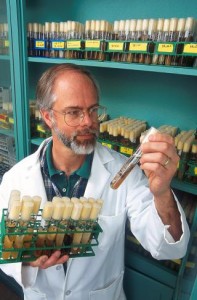 KB Home’s Runkle Canyon radiation tests questioned as more groundwater pollution is found and developer negotiates cleanup agreement with state
KB Home’s Runkle Canyon radiation tests questioned as more groundwater pollution is found and developer negotiates cleanup agreement with state
By Michael Collins
Ventura County Reporter – January 17, 2008
As soon as the Rev. John Southwick heard the latest round of Runkle Canyon soil testing for the leukemia-causing radionuclide strontium-90 (Sr-90) came back low, he started to question the results. After all, the Simi Valley resident reasoned, the picturesque canyon had previously tested 27 times higher than background for Sr-90. One hotspot, the closest one to the Boeing’s old Rocketdyne lab, had clocked in at 411 times “hotter” than normal for the area.
“Are we to believe that Runkle Canyon’s soil, which is next to the site of this country’s worst nuclear meltdown, the Santa Susana Field Laboratory (SSFL), tests cleaner than the background readings of Sr-90 in the area?” Southwick wrote in a Jan.7 letter to the city of Simi Valley, government regulators and the media. Citing the prior reports, he reasoned that “…the City’s recent split-sample results are nearly 104 times lower than these previous results. This demands explanation and hence our request for the entire Environmental, Inc. report which is a publicly-paid-for document and therefore, by law, you must provide.”
KB Home had hoped to build 461 residences in the 1,595-acre canyon, but those plans have been delayed since the summer of 2006 when Southwick and a cadre of residents who call themselves the “Radiation Rangers” (See: “Dirty Business,” Nov. 1, 2007) questioned the safety of the project. In May 2007, the Rangers had Runkle Canyon tested for heavy metals and found high levels of arsenic, nickel and vanadium which is documented in reports on their website StopRunkledyne.com. Later city tests found even higher levels as well as barium, cadmium, chromium and lead.
“KB Home has tried to assure the citizens of Simi Valley that the land is safe from Sr-90 contamination and generated their own Dade Moeller report,” Southwick continued in his letter, which also demanded the developer’s laboratory analysis. “This average is just 26.9 percent of the EPA’s background number for strontium-90 in the area.”
While the Rangers wait for the city and developer’s reports, a new document discloses a previously undetected carcinogenic contaminant in Runkle Canyon groundwater, trichloroethylene (TCE). The Reporter has obtained a December 2007 study of offsite pollution around SSFL prepared by an Arcadia-based environmental engineering firm MWH for Boeing, NASA and the Department of Energy which shows that TCE has been detected in approximately 10 percent of several dozen groundwater samples collected on Runkle Canyon property.
Around 1.73 million gallons of TCE were used at SSFL as a solvent to hose down rocket engines, as the Reporter first revealed during its investigation of the Runkle Canyon-adjacent Ahmanson Ranch development. That project tanked over toxic troubles in 2003 before becoming state park land (See: “Air Apparent,” Feb.13, 2003). Approximately 530,000 gallons of the carcinogen, which is a volatile organic compound, have seeped into the area’s groundwater. With the current rate of remediating TCE being less than 10 gallons a year at SSFL, it will take more than 50,000 years to clean up.
That is not good news for KB Home, since TCE vapors are extremely dangerous and can cause unconsciousness, impaired heart function and death. In December 2002, the EPA found that vaporized TCE is five times more hazardous at the same level of contamination than TCE in water. The agency revealed that the poisonous vapors have the potential to collect in structures that are built over shallow groundwater. This very disturbing phenomenon has occurred in several sites around the country, including homes in the Silicon Valley city of Mountain View.
The MWH report was generated for the California-EPA Department of Toxic Substances Control, which has been put in charge of the Rocketdyne cleanup, in order to ascertain the extent of pollution around the lab. The DTSC’s SSFL Project Director, Norm Riley, had previously pressured the city of Simi Valley and KB Home to have the developer invite the department to look into Runkle Canyon’s pollution problems.
The Reporter has learned that KB Home may do just that. “There is no agreement to show yet,” Riley said in an e-mail. “Just before Christmas, KB told me that it had decided to enter into a voluntary cleanup agreement (VCA) with DTSC, but that agreement has not been executed. I expect that this agreement, like most VCA agreements, will provide for a review by DTSC of all information related to conditions at the site, the possibility of additional work directed by DTSC, if necessary, and the possibility of cleanup directed by DTSC, if necessary, with KB paying all associated DTSC cost.”
24 Years of Award-Winning SSFL/Rocketdyne Reporting
June 1998 – June 2022












Recent Comments